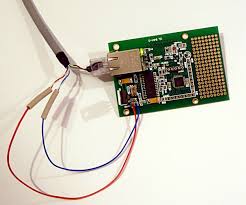Tele-graffiti is a technology that allows two or more users to communicate remotely via hand-drawn sketches. What one person writes at one site is captured by a video camera, transmitted to the other site and displayed there using an LCD projector.
 The system was developed at Robotics Institute of Carnegie Mellon university, Pittsburg. The system comprises of a digital camera, a high resolution LCD projector to project the received image, a mirror to reflect the projected image onto the paper, fixture to hold these devices in position and a writing pad to fix the sheet of paper on the top of the table at every station.
The user can write on a regular piece of paper with a pen at his desk. The sketch or writing on the paper is captured by the camera and transmits the digitized image to the receiving end through a data link.
The system was developed at Robotics Institute of Carnegie Mellon university, Pittsburg. The system comprises of a digital camera, a high resolution LCD projector to project the received image, a mirror to reflect the projected image onto the paper, fixture to hold these devices in position and a writing pad to fix the sheet of paper on the top of the table at every station.
The user can write on a regular piece of paper with a pen at his desk. The sketch or writing on the paper is captured by the camera and transmits the digitized image to the receiving end through a data link.
 The image can be transmitted over the internet or local area network. The software architecture of system runs on Linux and has four threads the drawing thread, the paper tracking thread, sending thread and receiving thread.
Tele-graffiti has various applications. It can play an important role in remote education and remote designing.
It can also serve as a substitute for internet chat. The advantage of the system is that non-computer people can use it. .
The image can be transmitted over the internet or local area network. The software architecture of system runs on Linux and has four threads the drawing thread, the paper tracking thread, sending thread and receiving thread.
Tele-graffiti has various applications. It can play an important role in remote education and remote designing.
It can also serve as a substitute for internet chat. The advantage of the system is that non-computer people can use it. .
 Power over Ethernet (PoE) is a revolutionarytechnology that extends the already ultra-broad functionality of Ethernet by supplying reliable DC power over the same twisted-pair cable that currently carries Ethernet data.
PoE, modeled after the technology used by the telecommunications industry to supply reliable power to telephones, enables lifeline quality power for IP telephones (VoIP) as well as many other low power Ethernet network devices like wireless access points (WAP) and security cameras.
When locating access points, system designers often use the availability of AC (alternating current) electrical outlets to base decisions on where to install access points. In some cases, companies only locate access points near AC outlets and within reach of a typical six foot electrical cord.
Power over Ethernet (PoE) is a revolutionarytechnology that extends the already ultra-broad functionality of Ethernet by supplying reliable DC power over the same twisted-pair cable that currently carries Ethernet data.
PoE, modeled after the technology used by the telecommunications industry to supply reliable power to telephones, enables lifeline quality power for IP telephones (VoIP) as well as many other low power Ethernet network devices like wireless access points (WAP) and security cameras.
When locating access points, system designers often use the availability of AC (alternating current) electrical outlets to base decisions on where to install access points. In some cases, companies only locate access points near AC outlets and within reach of a typical six foot electrical cord.
 Or, they'll look for a convenient location to install new outlets at points where it's suitable to run conduit and mount outlet boxes. All of these situations limit the location of access points and can incur significant costs if new outlets must be installed.
Power-over-Ethernet (PoE) solves these problems. A PoE solution only requires technicians to run one Ethernet cable to the access point for supplying both power and data.
With PoE, power-sourcing equipment detects the presence of an appropriate "powered device" (e.g., an access point or Ethernet hub) and injects applicable current into the data cable.
An access point can operate solely from the power it receives through the data cable.
Or, they'll look for a convenient location to install new outlets at points where it's suitable to run conduit and mount outlet boxes. All of these situations limit the location of access points and can incur significant costs if new outlets must be installed.
Power-over-Ethernet (PoE) solves these problems. A PoE solution only requires technicians to run one Ethernet cable to the access point for supplying both power and data.
With PoE, power-sourcing equipment detects the presence of an appropriate "powered device" (e.g., an access point or Ethernet hub) and injects applicable current into the data cable.
An access point can operate solely from the power it receives through the data cable.
 Engineering revision control developed from formalized processes based on tracking revisions of early blueprints or bluelines. Implicit in this control was the option to be able to return to any earlier state of the design, for cases in which an engineering dead-end was reached in iterating any particular engineering design.
Likewise, in computer software engineering, revision control is any practice which tracks and provides controls over changes to source code. Software developers sometimes use revision control software to maintain documentation and configuration files as well as source code.
In theory, revision control can be applied to any type of information record. In practice, however, the more sophisticated techniques and tools for revision control have rarely been used outside software development circles (though they could actually be of benefit in many other areas).
However, they are beginning to be used for the electronic tracking of changes to CAD files, supplanting the "manual" electronic implementation of traditional revision control.
As software is developed and deployed, it is extremely common for multiple versions of the same software to be deployed in different sites, and for the software's developers to be working privately on updates. Bugs and other issues with software are often only present in certain
Engineering revision control developed from formalized processes based on tracking revisions of early blueprints or bluelines. Implicit in this control was the option to be able to return to any earlier state of the design, for cases in which an engineering dead-end was reached in iterating any particular engineering design.
Likewise, in computer software engineering, revision control is any practice which tracks and provides controls over changes to source code. Software developers sometimes use revision control software to maintain documentation and configuration files as well as source code.
In theory, revision control can be applied to any type of information record. In practice, however, the more sophisticated techniques and tools for revision control have rarely been used outside software development circles (though they could actually be of benefit in many other areas).
However, they are beginning to be used for the electronic tracking of changes to CAD files, supplanting the "manual" electronic implementation of traditional revision control.
As software is developed and deployed, it is extremely common for multiple versions of the same software to be deployed in different sites, and for the software's developers to be working privately on updates. Bugs and other issues with software are often only present in certain
versions (because of the fixing of some problems and the introduction of others as the program evolves).
 Therefore, for the purposes of locating and fixing bugs, it is vitally important for the debugger to be able to retrieve and run different versions of the software to determine in which version(s) the problem occurs.
It may also be necessary to develop two versions of the software concurrently (for instance, where one version has bugs fixed, but no new features, while the other version is where new features are worked on).
At the simplest level, developers can simply retain multiple copies of the different versions of the program, and number them appropriately. This simple approach has been used on many large software projects.
Whilst this method can work, it is inefficient (as many near-identical copies of the program will be kept around), requires a lot of self-discipline on the part of developers, and often leads to mistakes.
Consequently, systems to automate some or all of the revision control process have been developed.
Therefore, for the purposes of locating and fixing bugs, it is vitally important for the debugger to be able to retrieve and run different versions of the software to determine in which version(s) the problem occurs.
It may also be necessary to develop two versions of the software concurrently (for instance, where one version has bugs fixed, but no new features, while the other version is where new features are worked on).
At the simplest level, developers can simply retain multiple copies of the different versions of the program, and number them appropriately. This simple approach has been used on many large software projects.
Whilst this method can work, it is inefficient (as many near-identical copies of the program will be kept around), requires a lot of self-discipline on the part of developers, and often leads to mistakes.
Consequently, systems to automate some or all of the revision control process have been developed.
 The image can be transmitted over the internet or local area network. The software architecture of system runs on Linux and has four threads the drawing thread, the paper tracking thread, sending thread and receiving thread.
The image can be transmitted over the internet or local area network. The software architecture of system runs on Linux and has four threads the drawing thread, the paper tracking thread, sending thread and receiving thread.



